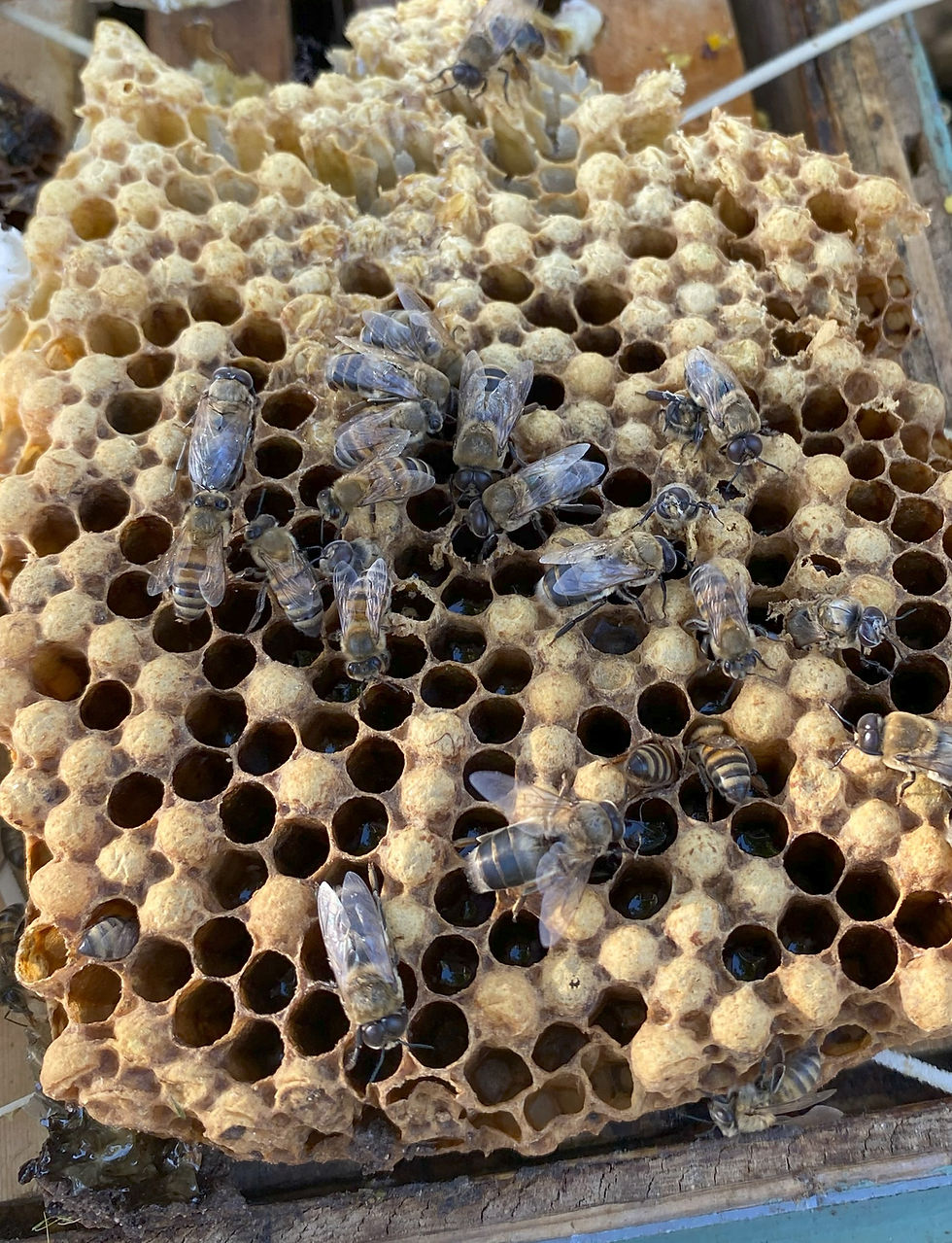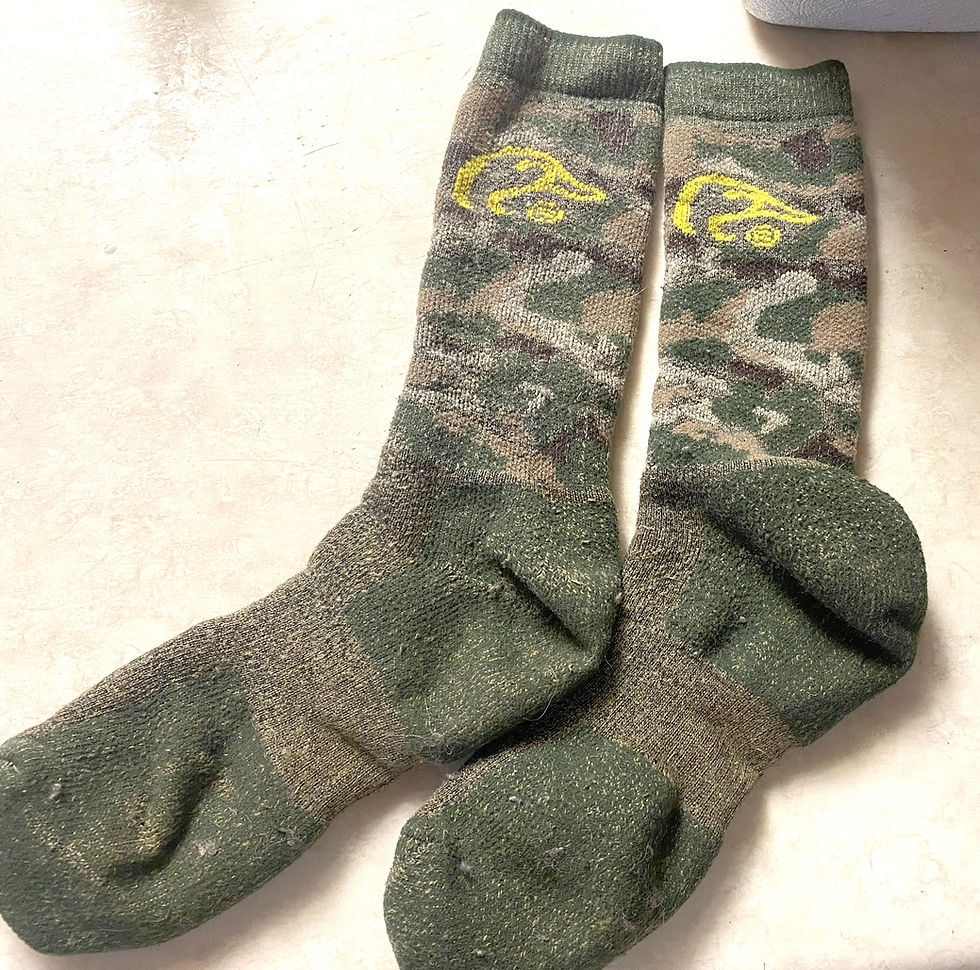Why Bees Are Throwing Out Drones as Fall Approaches.
- Pete Rizzo

- 20 hours ago
- 8 min read

Understanding Why Drones Get Ejected From The Hive.
As fall arrives in Las Vegas, beekeepers witness drones, large male bees, being forcibly expelled from hives. While this appears harsh, it's actually a sophisticated survival strategy refined over thousands of years.
Listen to This Article:
What Are Drones?
Drones are male honey bees with distinctive features: they're larger than workers with enormous compound eyes that often meet at the top of their heads, stockier barrel-shaped abdomens, and wings extending beyond their bodies.
Unlike females, drones completely lack stingers.
Their Role: Drones exist solely to mate with virgin queens from other colonies at Drone Congregation Areas 30-130 feet above ground. They don't forage, produce wax, feed themselves, clean the hive, care for brood, or defend the colony. Workers must feed them continuously.
Development: Drones develop from unfertilized eggs over 24 days, then require 14 additional days to reach sexual maturity, 38 days total versus 21 for workers. They consume three times more food during development and require constant feeding as adults.
Resource Impact: A healthy colony may support 200-700 drones during summer, representing 5% to 10% of the population. This investment pays off during mating season but becomes unsustainable as conditions change.
Why Drones Get Ejected
Resource Management
Fall brings dramatic environmental shifts in desert climates. Wildflower blooms diminish, nectar flows decrease, and pollen sources become scarce.
Las Vegas temperatures swing from 110°F summer highs to 40°F fall nights, signals that winter approaches.
Worker bees instinctively know survival depends on adequate honey stores. A colony needs 30-60 pounds of honey for winter. Maintaining hundreds of drones could consume 10-20% of these critical reserves. Every ounce eaten by drones threatens winter survival.
End of Mating Season
By late summer, most queen mating has concluded. Cold temperatures make mating flights impossible (queens mate above 68°F), and colonies won't raise new queens until spring. Keeping sexually mature but inactive drones serves no biological purpose.
Trigger Mechanisms
Multiple signals trigger ejection: decreasing daylight hours, temperature drops, reduced brood rearing, pheromone changes, and declining forage availability. These cues activate the colony's conservation instincts.

Early Ejection: When It Happens Sooner
Normal ejection in Las Vegas occurs September-October, but sometimes happens as early as July-August. This can indicate:
Natural Causes: Extended poor weather making workers perceive early winter, paradoxically high honey stores (once adequate reserves exist, drones become expendable), or genetic factors, Russian bees eject earlier than Italians.
Health Concerns: Varroa mites preferentially reproduce in drone brood, producing 2.2 offspring per drone cell versus 1.3 per worker cell.
Mites infest drone cells 8-11 times more frequently. Colonies may remove infested drone brood showing deformities. Other stressors include disease, pesticide exposure, poor nutrition, or queen problems.
How Ejection Happens
Worker bees employ various tactics:
Blocking Entry: Guard bees prevent returning drones from re-entering, sometimes for days until they die of exposure or starvation.
Active Removal: Groups of 2-4 workers grab drones and drag them toward exits, sometimes biting wings to prevent flight or physically throwing them from entrances.
Brood Removal: Workers uncap drone cells, drag out pupae, and discard entire combs of immature drones within days.
The process typically unfolds over 2-4 weeks, from initial signs through peak removal to completion when the hive contains only queen and workers.

What Beekeepers Will Observe
At the Entrance: Dead or dying drones accumulate below the hive. Struggling drones with damaged wings wander the landing board. Workers actively fight with or drag drones. White or tan immature drones appear expelled. Guards aggressively prevent drone entry.
Inside the Hive: Former drone cells sit empty and cleaned. Workers fill drone comb with honey. Dramatically fewer drones appear during inspections.
Regional Timing: Desert climates like Las Vegas see ejection September-October (as early as August in drought). Temperate climates experience August-September completion. Southern year-round warm areas may show reduced or no ejection.
Normal vs. Problematic Ejection
Healthy Signs: Timing aligns with seasonal changes, good honey stores exist, active queen with solid brood pattern, normal-appearing drones, strong worker population, no disease signs, similar behavior in nearby colonies.
Warning Signs: Drones with deformed wings or shortened abdomens, spotty brood patterns, crawling bees, foul odors, limited honey stores (under 2-3 frames), no fresh nectar or pollen, aggressive foraging, robbing attempts, or absence of recent brood.
Varroa Mites and Drone Management
Smart beekeepers exploit mite-drone relationships through drone trapping: insert drone foundation frames, allow development, remove when 80%+ cells are capped (before emergence), freeze for 48 hours to kill mites and brood, then return or replace.
This can reduce mite populations by 25-50% when timed correctly through spring and early summer.

Supporting Your Colony
Fall Management: Assess honey stores (minimum 30-40 lbs), verify queen presence and laying, check for disease and pests, evaluate population strength, perform mite counts, and begin winter preparation with entrance reducers and mouse guards.
Feeding: Supplement colonies with less than 30-40 lbs stored honey using 2:1 sugar syrup. Don't feed colonies with adequate stores, during nectar flows, or in extreme heat without ventilation.
Why This Ensures Winter Survival
Winter cluster maintenance requires workers to generate heat by shivering flight muscles, maintaining 93°F in the cluster core.
Removing drones allows tighter cluster formation, more efficient heat retention, better access to stores, and reduced disease transmission.
Spring brings renewal: queens begin laying in late winter as temperatures warm and daylight increases. Within 4-6 weeks, they lay drone eggs. New drones emerge 6-10 weeks after initial laying and reach sexual maturity 8-12 weeks later.
Common Misconceptions
Drone ejection doesn't mean your hive is sick, it indicates appropriate winter preparation. You shouldn't try to save ejected drones, as they cannot survive independently and interfering contradicts colony intelligence.
Colonies don't need drones for winter survival; new ones will be raised when needed. Timing naturally varies 4-6 weeks even within the same apiary based on genetics, conditions, and colony strength.
FAQ Section
Why do honey bees eject drones in fall?
A: Drones are expelled to conserve resources as winter approaches. They consume honey but don’t contribute to thermoregulation, foraging, or brood care, making them expendable when the colony prepares for survival.
Are drones harmful to the hive?
A: No. Drones are not harmful. They are simply resource-intensive males whose primary role is mating, and their removal is a natural survival strategy.
When does drone ejection typically occur in Las Vegas?
A: Usually from September to October, though early ejection can sometimes occur as soon as July or August, depending on colony strength, weather, and genetics.
Can early drone ejection indicate a problem?
A: Sometimes. Early ejection can signal stress from Varroa mites, disease, poor nutrition, pesticide exposure, or queen health issues. If the colony is strong and well-fed, early ejection may be normal.
How do worker bees eject drones?
A: Workers block drones from re-entering the hive, drag them toward exits, or remove immature drone brood from cells. The process takes 2–4 weeks and gradually leaves the colony with only queen and workers.
Should beekeepers try to save ejected drones?
A: No. Drones cannot survive independently outside the hive. Interfering with this natural process can harm the colony.
How can beekeepers support hives during drone ejection?
Ensure adequate honey stores, check queen health, monitor for disease and mites, and begin winter preparation by using entrance reducers, mouse guards, and ventilation.
What role do Varroa mites play in drone ejection?
Varroa mites preferentially infest drone brood, reproducing more successfully than in worker cells. Colonies may remove infested drones as a hygienic response, which helps limit mite populations.
Do all honey bee species eject drones in fall?
Most temperate-climate honey bees do. Tropical species may maintain drones year-round, while bumble bees and other pollinators have different life cycles.
Will my colony raise new drones after winter?
Yes. Queens begin laying drone eggs in late winter or early spring as temperatures rise and daylight increases, ensuring males are available for mating season.
Why Honey Bees Stop Raising Drones in Fall
As autumn approaches and temperatures drop, honey bee colonies undergo a dramatic shift in their reproductive strategy.
Drone eviction becomes one of the most visible signs that winter preparation is underway. Worker bees forcibly expel male drones from the hive, pushing them toward the entrance and refusing to let them back inside.
This drone eviction behavior may seem cruel, but it's a survival strategy refined over millions of years.
Understanding why drones die in fall requires recognizing their sole purpose: mating with virgin queens.
During spring and summer, colonies invest substantial resources in raising drones, anticipating the need for genetic diversity in drone congregation areas, specific aerial locations where drones from multiple colonies gather to mate with queens.
However, once mating season ends and no new queens require fertilization, drones become a liability rather than an asset.
The drone honey bee lifespan is considerably shorter than that of workers, typically lasting only 4-8 weeks during active season.
Unlike worker bees, drones cannot forage, defend the hive, or contribute to winter cluster warming.
They exist purely for reproduction, consuming precious honey stores without offering any return on investment once mating opportunities cease.
What happens to drones after mating is particularly stark, successful mating results in immediate death, as the drone's reproductive organs are torn from his body during the act. For those that don't mate, the outcome is equally grim.
Drone brood removal begins in late summer as workers cease feeding drone larvae and may even drag developing drone pupae from their cells, terminating the drone brood cycle entirely.
Signs of drone eviction include drones clustered desperately at hive entrances, workers aggressively biting and pulling at drones, and deceased drones littering the ground near the hive entrance.
Many beekeepers wonder do drones return to the hive after being evicted and the answer is no. Once expelled, drones lack the ability to survive independently.
Without access to food stores or the warmth of the winter cluster, drone mortality is inevitable within days.
This ruthless efficiency ensures the colony enters winter as a lean, efficient unit composed entirely of female workers capable of generating heat and a queen to restart reproduction come spring.
Let's Wrap it Up
Drone ejection represents millions of years of evolutionary refinement. Worker bees ensure colony survival by eliminating non-essential members who would consume critical resources.
For beekeepers, understanding this behavior provides valuable insight into colony health and seasonal preparation. It may be sad to us, but we always trust in the bees.
Betsy & Pete
🐝Las Vegas’s All-Natural Live Bee Removal Team
About Us: The Authors

We’re Betsy and Pete - Beekeepers on a Mission in Las Vegas
We’re not just in the bee business, we’re in the bee-saving business. Trained by a master beekeeper and backed by hundreds of successful removals, we are dedicated to rescuing and relocating honey bees with care and precision.
Every swarm we save and every hive we manage reflects our deep love for the bees.
At our Joshua Tree Preserve in Arizona, we care for dozens of thriving hives. Some wild, some honey-bearing, and all are part of our commitment to ethical, sustainable beekeeping.
Why Vegas Bees? Because We Never Stop Learning or Caring
Beekeeping is always evolving, and so are we. We stay on the cutting edge by continuing our education, connecting with fellow beekeepers, and refining our beekeeping practices and techniques to ensure the best outcomes for both bees and people.
Whether it’s advanced bee removal strategies or the latest natural methods, we’re always one step ahead.
We’re also proud to support the beekeeping community with high-quality beekeeping supplies for everyone. If you’re ready to suit up and start your journey, we’ve got what you need.
.png)


